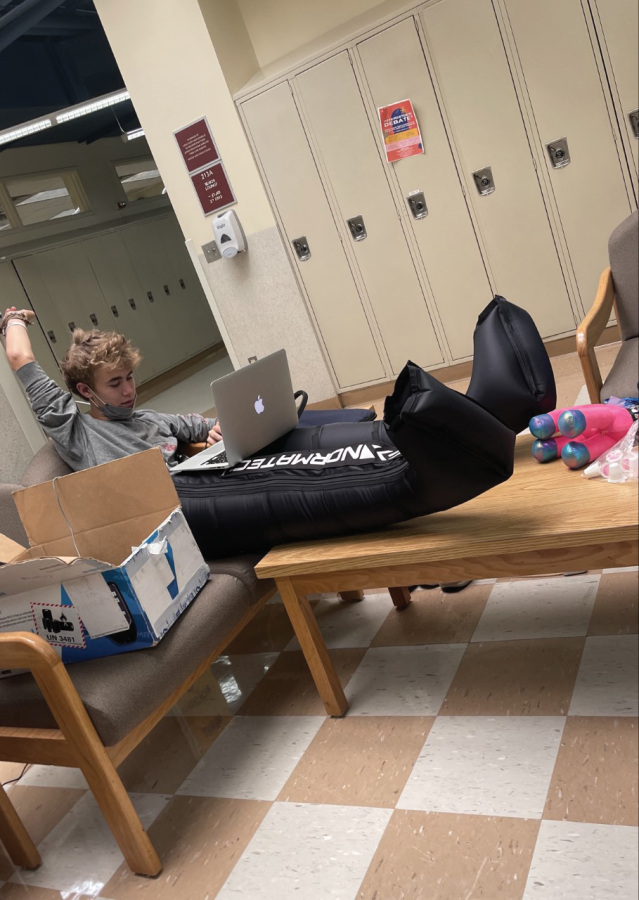Grounded runners
Injuries present hurdles in an already challenging sport
Photo used with permission of Eli Gordon
Portnoy air massages his legs while in his free period. He typically uses his Normatec at least three times a week, and this technology helps prevent stiffness in his legs.
December 16, 2021
As senior Brandon Portnoy reaches the finish line, his legs are giving in, and his body has reached its endpoint. Feeling mentally and physically drained, he aches for an excuse to end his race. However, after catching a glimpse of his teammates and coaches cheering him on, he perseveres and reaches the finish line, thrilled to have gotten through his race without giving up.
Because running is such a strenuous sport, injuries are inevitable. However, head cross-country coach Jason Belinkie redesigned the cross-country program this year in an effort to help members of the team combat injuries.
“I would actually phrase it as more being proactive around physical and mental health,” Belinkie said. “This involves working with bands, focusing on meditation and placing an emphasis on stretching.”
Although many may perceive cross-country to be an individual sport, injuries have a major impact on the team.
“On average, almost all girls suffer from some sort of injury throughout the season; typically half the boys’ team does as well,” Belinkie said. “However, it’s hard to say what the average time off is, because injuries are so individualized.”
Injuries are often seen more in girls because their bodies and bone structure are constantly changing as they go through puberty, and the pressure that running puts on their bones makes them more prone to injuries.
Since runners get injured at different times throughout the season and are often forced to miss important meets, the team dynamic is constantly changing.
“When my teammates are injured and can’t come to meets, group runs and Sunday workouts, the dynamic of the team completely shifts,” Portnoy said. “When I’m not there due to an injury, I’m missing them and my mood instantly depletes.”
Even with these obstacles, the Boy’s varsity cross-country team succeeded in winning the 2021 cross-country PVAC and state championships. However, on the path to their titles, many members of the team suffered injuries. The most common injuries were runner’s knee and shin splints.
“I think people get injured so easily because they aren’t putting in the time to strengthen themselves. I am guilty of this myself,” Portnoy said. “Yes, of course, I overwork myself, as do many others on the team, but that’s just the nature of running.”
Portnoy has suffered through shin splints and runner’s knee. Although these injuries are painful and made his season more difficult, they did not force him out for a long period of time.
Senior Julia Peppe was not so lucky. Peppe suffered from Achilles tendinitis and a labral tear on her hip that required her to get surgery and take a year long break from running.
“You can either stop running and change your lifestyle a little bit to accommodate [it], or you can have the surgery, which I chose,” Peppe said.
Peppe’s hip had been bothering her since the winter after her sophomore cross-country season. She took time off from running for a year and when she returned in the fall of her junior year, her hip hurt even more than before. She took another break and began running again very lightly during the summer going into senior year, but the hip problem worsened, forcing her to make the tough decision to get surgery and end her senior season.
Although these injuries can present an obstacle, many describe the feeling of getting through it and rejoining the team as rewarding.
“The most compelling, best kind of situations where leaders form, are when they are injured, overcome a lot, but choose to return to the team,” Belinkie said.








